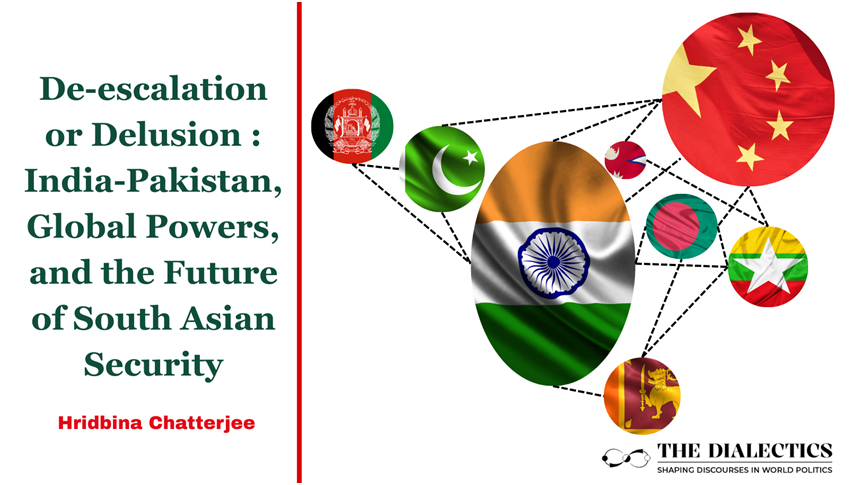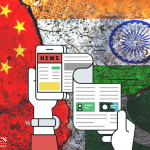South Asian subcontinent, a region teeming with history, a vibrant culture, and an ascending population, where it struggles to exist on the edge of global turbulence in an increasingly multipolar world. The ongoing rivalry between India’s and Pakistan’s nuclear-armed status is still a significant flashpoint, and as its trajectory changes due to newly formed perceptions and strategies of the United States, China, Russia, and the Gulf Cooperation Council (GCC) the situation has escalated but further exposes the precarious nature of this equilibrium that is contested by domestic rivalries and variable external influences that define South Asia’s conundrum of security. The escalating nature of regional friction in early May 2025 has brought into focus the armament of South Asia and the concomitant risk of miscalculation due to its increasing potential to draw in multiple external forces.
The India-Pakistan relationship has, since independence in 1947, perpetually been defined by mutual suspicion and hostility. The problem of Kashmir, cross-border terrorism, and historical grievances have led to episodic crises, (of which the first week of May 2025 is an example). The latest crisis began with India’s missile strikes under “Operation Sindoor” targeting alleged militant infrastructure in Pakistan after the deadly attacks of 04 May in Indian-administered Kashmir. This crisis escalated quickly into retaliatory strikes and drone battles. With these exchanges being historically significant (the first instance of drone warfare between two nuclear-armed states, as well as the provision of drone strikes against military facilities anywhere other than directly along the border), these exchanges have greatly weakened traditional red lines. Although a fragile ceasefire, brokered on May 10th, has brought about an uneasy reprieve, the severe underlying conditions remain and the potential for future conflagrations is significant.
In this complex environment, perceptions and actions taken by the major global powers are critical, albeit often indirect. Since the end of the Cold War, the United States has, in previous decades, been required to reckon with events in South Asia as there have been patterns of dysfunction and crises leading to questions of viability and stability at the forefront of any American vision. The United States is aware of the strategic elements of South Asia, but tends to view politics in South Asia as a reflection of its wide ranging strategic relationship with the region, namely to contain the rise of China. Given this, the United States almost consciously formed a new strategic partnership with India from the mid-2000s onward to be a counterweight to China’s rising power and assertiveness in the Indo-Pacific, which would be the organizing geopolitical feature in regional security. As a mature relationship, this partnership has developed into significant new areas of defence cooperation, intelligence sharing, and diplomatic support for India on international platforms. In this regard, during the crisis in May 2025, the US was calling publicly for restraint from both sides while quietly supporting India’s narrative of counter-terrorism. However, the US was also very much aware of the risks of escalation below the threshold of nuclear use between two nation-states that were both nuclear armed, as deterrents, and despite the deliberate creation of space for restraint reduced India and Pakistan to subliminally reassess their respective engagement and restraint, privately the US administration would have taken measures. Despite signalling that due to their inherent weaknesses both nation-states were “subject to self-destructive behaviour” in a crisis situation, the US administration needed to signal some degree of restraint in the context of policy decisions regarding due process. The US recognized India’s burgeoning military and economic burden and was supportive of devising a South Asia that avoided clear headedness and to allow India to project its power eastward in the region as a balance of power in Asia.
Owing to the strategic partnership between China and Pakistan and the broader aim of increasing its influence across Asia, China maintains a certain standpoint with regard to the India-Pakistan dynamics. China regards Pakistan as an important conduit on the BRI, but also as a means to keep India engaged along its western border so New Delhi would not be completely distracted from its eastern border with China. While in May 2025 China stated that dialogue between India and Pakistan is necessary and that de-escalation of tension was desirable, it again indirectly affirmed Pakistan’s position. The language so often employed by China calls on both sides to settle their disputes amicably, yet it never goes so far as to condemn Pakistan-based militant groups, which India looks upon with deep suspicion. The increased economic and military investment by China in Pakistan provides it with certain levers with which to influence Pakistan’s strategic calculations vis-à-vis India. That said, a full-blown war would not be in the interest of China, for the Indo-Pak war could bring severe instability in the region, thus theoretically destabilizing any offshoot economic corridors as well as its own broader geopolitical aspirations in the region. China would prefer a state of managed tension with Pakistan as a strategic asset, but not one that escalates into a broader conflict in which China might ultimately get involved.
Russia, a historically close partner of India, is starting to find itself in a more complicated position in the evolving multipolar order. While Moscow continues to maintain a strong defense relationship with New Delhi and considers it a key partner to its own multipolar vision, it started to enjoy progressively warmer ties with Pakistan over the last few years. During the May 2025 crisis, Russia adopted a neutral stance, calling for both parties to work to exercise restraint and resolve their issues peaceably. This measured approach speaks to the fact that Russia would like to avoid a situation where it has to take sides between India and Pakistan. Russia’s strategic interests in South Asia are primarily focused on ensuring regional stability and stemming the tide of Islamist extremism- issues that all three countries share although from different perspectives. Moscow also wants to enhance its economic and energy relations in the region, and views India and Pakistan as important components to its broader Eurasian strategy. A protracted conflict between India and Pakistan could be problematic for Russia- it could jeopardize its relationship with both countries, as it is still selling arms of high quality and to high amounts to India.
While the Gulf Cooperation Council (GCC) states have not historically had a strong role to play in the security dynamic between India and Pakistan, they have a growing relevance in that dynamic due to their economic and energy links, as well as the cutting energies of large expatriate communities from the subcontinent. The GCC’s interest centers on stability in the region for reliable energy and remittance flows. During the crisis in May 2025 when conventional conflict nearly broke out between India and Pakistan, the GCC states called individually and collectively for restraint and warned of the regional consequences of escalating hostilities. Their economic relationships with India and Pakistan provide information for them to have a vested interest in an environment of peace. India is still a large oil and gas consumer of GCC states and millions of Indian expatriates work in them which contributes greatly to their economies and remittances. Pakistan has economic and labor relationships that are also similar to the GCC states. An extended period of conflict could have economic consequences for the GCC as well with precious energy markets and continuing flows of remittances. Thus, the GCC uses its political influence through diplomacy encouraging dialogue and de-escalation.
The recalibration of these great powers’ positions in 2025 is the recognition of the changing multipolar balance. The United States continues to deepen its strategic relationship with India as a central anchor of its Indo-Pacific strategy, even as it manages the dangers of Indo-Pakistani conflict. China is firm in its backing of Pakistan as a central component of its regional power projection and as a counterbalance to India but also wishes to prevent a large-scale conflict. Meanwhile, Russia is working to balance its traditional relationship with India with intensified relations with Pakistan, emphasizing regional stability and its own multipolar aspirations. The GCC states, given their extensive economic and demographic ties to South Asia, became more vocal in their proclamations for peace.
The May 2025 India-Pakistan crisis serves as a stark reminder of the enduring security dilemma in South Asia. The unique convergence of historical animosities, long-standing territorial disputes, and the dynamics and influences of global power creates a volatile security environment. While the immediate crisis has been contained by a fragile ceasefire, the underlying tensions remain and there is the potential for future crises. Moreover, the domestic calibrations of global powers in the multipolarity of today — the US affirming its partnership with India, China continuing its support of Pakistan, Russia seeking to maintain a balance, and the GCC pushing for stability – will shape the trajectory of the situation in this critical regional flashpoint going forward. India’s and Pakistan’s ability to manage their own rivalry while navigating the external influences and pressures will be critical in going forward and in maintaining semblances of peace and stability in a region that is geopolitically significant in the 21st century. The role of the international community and its global powers cannot be overstated in positively channeling dialogue, stipulating and cushioning trust-building measures, and preventing miscalculations that may lead to devastating conflict on this nuclearized subcontinent.





